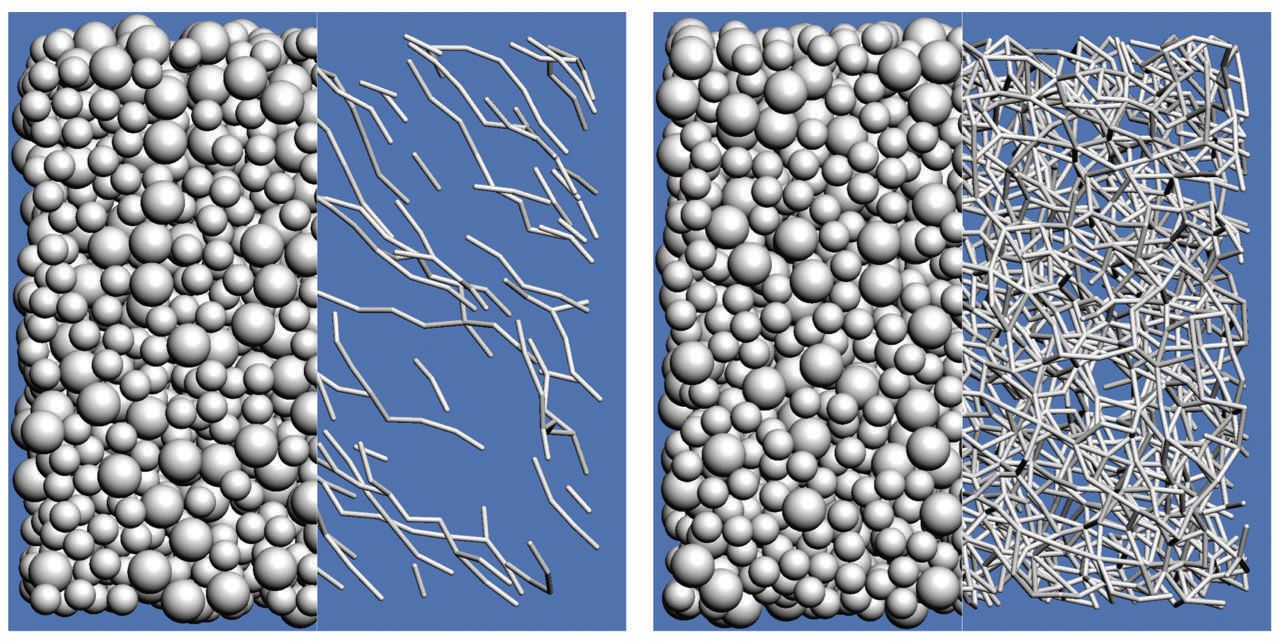Modeling of sudden fluid thickening
Dr. Neil Canter, Contributing Editor | TLT Tech Beat April 2014
A new model explaining discontinuous shear thickening focuses on the frictional contact between particles.
KEY CONCEPTS
•
Discontinuous shear thickening (DST) occurs when high shear is applied to a concentrated suspension, leading to a dramatic increase in thickening.
•
A new model has been developed to explain that DST involves the formation of a three-dimensional force chain network.
•
Once stress is applied, hydrodynamic forces force the particles together to initiate contact and friction.
DUE TO THE LARGE NUMBER OF COMPONENTS used in formulating, lubricants can be considered complex fluids. With some of the components in suspension, there can be times when the fluid may suddenly thicken in response to changes in parameters such as shear and viscosity.
In a previous TLT article, a related process in which fast shear or sudden impact to a dense suspension of cornstarch in water was studied (
1). The net effect of applying such stress to a 50 percent suspension of cornstarch in water was the immediate formation of a solid. Stress in the form of an aluminum rod striking the cornstarch suspension leads to the formation of a propagation front of solidification that is similar to how a snow plow operates.
Application of high shear to a concentrated suspension can lead to a dramatic increase in thickening through a phenomenon known as discontinuous shear thickening (DST). Jeffrey Morris, professor of chemical engineering at The City College of New York in New York, N.Y., says, “DST is very abrupt once sufficient shearing is done to a concentrated suspension. A small, say factor of two, increase in shear rate can lead to orders of magnitude rise in fluid viscosity. There is no intermediate state seen, which means that the fluid either displays low viscosity or high viscosity.”
Several mechanisms have been proposed in the past to explain how DST occurs. Morris says, “Two possibilities are the order-disorder mechanism and hydroclustering. Order-disorder describes how a fluid moves from a low-viscosity state in a shear thinning regime to an unstable, disordered viscous state. Hydroclustering was taken directly from fluid mechanics and proposes that the thickening is due to particles clustering together in response to high shear.”
Neither of these mechanisms fully explains how DST takes place. A new model has now been proposed to explain the origin of DST. One prominent factor that is extremely important in this model is friction.
THREE-DIMENSIONAL FORCE CHAIN NETWORK
Morris M. Denn, Albert Einstein Professor of Science and Engineering at The City College of New York, along with Drs. Jeffrey Morris, Ryohei Seto and Romain Mari, have developed a new model to explain DST that focuses on the frictional contact between particles. This model was prepared through the use of simulations that predict DST.
The numerical modeling simulations were done using Lees-Edwards boundary conditions. Cubic simulation boxes containing 512 particles and rectangular parallelepipeds were used.
Morris says, “For us, DST represented a classical fluid mechanics problem. In a hydrodynamic regime, forces are present to keep two smooth surfaces away from each other. As the surfaces get closer to each other, the film ruptures. This leads to a seizing condition on the local scale in a similar fashion to a journal bearing seizing.”
In high concentrations, if one accepts that the particles must be in contact with each other, friction is generated as they rub against each other. The researchers determined how DST might occur from two aspects. Morris says, “Background on the particle interactions comes from analyzing DST, first as a fluid problem and then using ideas from the granular literature to incorporate friction. We combined these two aspects and introduced the key ideas of friction and viscosity.”
Denn added, “A key ingredient of the DST model is the force chain concept derived from the granular literature. Structural transmission of forces moves from particle to particle in a manner that looks like a series of chains.”
In the initial fluid state prior to the application of stress, the particles flow at a low viscosity and do not generate any friction because they do not come in contact. As stress is applied, the hydrodynamic forces push the particles together to initiate contact and friction. At this point, they start to act as a single entity. This leads to the formation of force chains that are used by the particles to transmit the stress in one direction. The left image in Figure 2 shows the stressed particles on the left side and the force chains formed as a result are on the right side.
 Figure 2. A new model for discontinuous shear thickening proposes that particles upon initial application of stress get pushed together and form force chains, as shown on the left side of the figure. Further stress leads the particles to form a three-dimensional force chain network, as shown on the right side of the figure. (Courtesy of The City College of New York)
Figure 2. A new model for discontinuous shear thickening proposes that particles upon initial application of stress get pushed together and form force chains, as shown on the left side of the figure. Further stress leads the particles to form a three-dimensional force chain network, as shown on the right side of the figure. (Courtesy of The City College of New York)
With the increase in stress, the viscosity of the fluid radically increases, and this changes the behavior of the particles. It is not only the viscosity that increases, according to Morris. He says, “The particles want to expand and get more space.”
Eventually, the particles transmit the stress not just in one direction but in all directions. Denn says, “The force developed on the particles is relieved by having chains form in three dimensions, leading to the formation of a dense network.” This three-dimensional network is seen in the right side of the right image shown in Figure 2.
Another way to look at DST is by understanding the concept of shear induced jamming. Morris says, “The transition to DST is very similar to a shear jammed state in which shearing a system causes a transition to a solid that becomes so robust that it will stop fluid flow. This effect is seen in such applications as powder-injection molding where the material being forced into a mold can seize up and not move.”
Future work will focus on determining the detailed structure for the three-dimensional chains and figure out how they transmit stress. Additional information can be found in a recent article (
2) or by contacting Morris at
morris@ccny.cuny.edu.
REFERENCES
1.
Canter, N. (2012), “Impact-activated solidification,” TLT,
68 (10), pp. 12-13.
2.
Seto, R., Mari, R., Morris, J. and Denn, M. (2013), “Discontinuous Shear Thickening of Frictional Hard-Sphere Suspensions,”
Physical Review Letters, 111 (21), p. 218301.
 Neil Canter heads his own consulting company, Chemical Solutions, in Willow Grove, Pa. Ideas for Tech Beat items can be sent to him at neilcanter@comcast.net
Neil Canter heads his own consulting company, Chemical Solutions, in Willow Grove, Pa. Ideas for Tech Beat items can be sent to him at neilcanter@comcast.net.